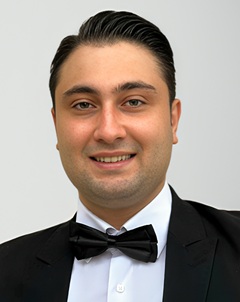
In light of a recent meta-analysis evaluating the potential benefits of administering intra-arterial thrombolysis (IAT) after an endovascular thrombectomy (EVT) procedure in large vessel occlusion (LVO) stroke patients, Ali Mortezaei (Houston, USA)—who was a leading author for the publication—discusses key outcomes associated with giving postprocedural thrombolytics, and highlights which patients may respond best to this approach.
EVT has transformed the management of LVO acute ischaemic stroke. Yet, even with angiographic revascularisation rates over 80%, fewer than half of all LVOs1 and distal or medium vessel occlusions (DMVOs)2,3, as well as fewer than one third of large strokes (Alberta stroke programme early computed tomography score [ASPECTS] 0–5)4,5, achieve disability-free survival at 90 days. This ‘reperfusion gap’ reflects an important limitation: opening the artery does not always mean restoring tissue-level flow or functional recovery.
The reasons are multifactorial. EVT removes proximal clot, but residual thrombus, distal emboli and microvascular no-reflow often remain.6,7 These issues are magnified in DMVOs, where vessel calibre, tortuosity and fragility make intervention less feasible, and more challenging.8 But is IAT a breakthrough tool for better outcomes, or a risky addition with uncertain benefits?
Our recently published meta-analysis of seven randomised trials included a total of 2,101 patients, with well-balanced baseline characteristics, and without any significant heterogeneity in any primary and secondary outcomes.9 The findings showed a significantly higher rate (24%; p<0.01) of functional excellence (modified Rankin scale [mRS] 0–1) in the EVT group compared with medical care, without any difference in functional and quality-of-life outcomes. Although the risk of any intracranial haemorrhage (ICH) was significantly greater in the intervention group (17%; p=0.03), there was no significant difference regarding symptomatic ICH between the two groups (p=0.53). When data were limited to anterior-circulation patients, notably, there was no significant difference (p>0.05) in systemic bleeding, serious adverse events, and symptomatic and any ICH between groups. However, the superiority of EVT over medical care in functional excellence was sustained.
Another important question is which thrombolytic agent works best in this setting. In our analysis, there was no significant difference between alteplase, tenecteplase and urokinase in terms of functional recovery or mortality at three months. This suggests that the benefit of IAT is likely a class effect rather than being agent-specific. Importantly, patients who received both IAT and intravenous thrombolysis (IVT) did not fare better than those treated with IAT alone, underscoring that it is the targeted, local delivery rather than systemic exposure that seems to matter most. For clinicians, these results suggest that the choice of thrombolytic agent may be less critical than ensuring consistent delivery, and that future work should focus on standardising dosing protocols and infusion techniques as opposed to emphasising differences between individual agents.
One point that is often raised is the fact that “not all patients respond to IAT the same way”—so, which patients benefit the most? Patients with severe baseline neurological deficits (National Institutes of Health stroke scale [NIHSS] >15) had a greater chance of achieving disability-free survival (risk ratio [RR], 1.38; 95% confidence interval [CI], 1.07–1.78; p=0.01), likely reflecting a larger salvageable penumbra where distal reperfusion is particularly meaningful. Even more intriguing was the sex-based difference: female patients had a 42% higher likelihood of excellent outcomes (mRS 0–1) compared with men (95% CI, 1.07–1.78; p<0.01). While exploratory, this signal is consistent with prior observations that hormonal milieu, clot composition and collateral circulation may influence responsiveness to fibrinolysis.
By contrast, no significant differences were observed when patients were stratified by age (≤69 vs >69 years), infarct size (ASPECTS ≤8 vs >8), pre-stroke functional status (mRS 0 vs 1), occlusion site, or post-EVT reperfusion grade (expanded thrombolysis in cerebral infarction [eTICI] 2c vs 3). These neutral findings underscore that IAT’s effect is not uniform across all baseline or imaging characteristics but, rather, concentrated in selected subgroups. It is important to note that neutral findings may reflect limited power rather than a true absence of effect. Altogether, the data raise the possibility that IAT could be especially impactful in populations historically at higher risk of poor outcomes—a hypothesis that warrants validation in prospective, subgroup-focused trials.
IAT after EVT is not a ‘one-size-fits-all’ solution. While overall effects are modest, exploratory signals suggest benefit in patients with severe strokes and possibly in women, without an excess risk of symptomatic ICH. The choice of thrombolytic agent appears less important than how and when it is delivered, underscoring the need for standardised administration. It remains unclear whether IAT confers benefit in patients with reperfusion below eTICI 2c–3, as available data were insufficient to draw conclusions for this subgroup. Most importantly, IAT may help close the reperfusion gap that persists after EVT and could prove especially valuable in challenging populations, such as DMVOs, where mechanical thrombectomy has struggled. By potentially improving disability-free survival, IAT may hold promise as an adjunct to thrombectomy. Its greatest value, however, will likely come from tailored use in carefully selected patients and the development of standardised protocols in future trials.
References:
- Goyal M, Menon B K, Van Zwam W H et al. Endovascular thrombectomy after large-vessel ischaemic stroke: a meta-analysis of individual patient data from five randomised trials. Lancet. 2016; 387(10029): 1723–31. DOI: 10.1016/S0140-6736(16)00163-X.
- Psychogios M, Brehm A, Ribo M et al. Endovascular treatment for stroke due to occlusion of medium or distal vessels. N Engl J Med. Published online 10 April 2025. DOI: 10.1056/NEJMoa2408954.
- Goyal M, Ospel J M, Ganesh A et al. Endovascular treatment of stroke due to medium-vessel occlusion. N Engl J Med. Published online 10 April 2025. DOI: 10.1056/NEJMoa2411668.
- Mortezaei A, Morsy M M, Hajikarimloo B et al. Endovascular thrombectomy for ischaemic stroke with large infarct, short- and long-term outcomes: a meta-analysis of six randomised control trials. Neurol Sci. 2024; 45(12): 5627–37. DOI:10.1007/s10072-024-07662-x.
- Mortezaei A, Essibayi M A, Abdelsalam A et al. Long-term (12 months) outcomes of endovascular thrombectomy for large stroke: a meta-analysis of SELECT2, TESLA, TENSION, and LASTE trials. Am J Neuroradiol. Published online 26 March 2025. DOI: 10.3174/ajnr.A8749.
- Regenhardt R W, Etherton M R, Das A S et al. Infarct growth despite endovascular thrombectomy recanalisation in large vessel occlusive stroke. J Neuroimaging. 2021; 31(1): 155–64. DOI: 10.1111/jon.12796.
- Ng F C, Churilov L, Yassi N et al. Prevalence and significance of impaired microvascular tissue reperfusion despite macrovascular angiographic reperfusion (no-reflow). Neurology. 2022; 98(8): e790–e801. DOI: 10.1212/WNL.0000000000013210.
- Sporns P B, Almohammad M, Minnerup J et al. Navigating the distal vasculature: challenges and lessons learned from failed thrombectomy trials. Interv Neuroradiol. Published online 14 August 2025; accessed 25 August 2025. DOI: 10.1177/15910199251365526.
- Mortezaei A, Al-Saidi N, Li Y L et al. Intra-arterial thrombolysis after successful endovascular reperfusion for large vessel occlusion stroke: a meta-analysis of randomised seven controlled trials. Interv Neuroradiol. Published online 13 August 2025: 15910199251367556. DOI: 10.1177/15910199251367556.
Ali Mortezaei is an MD graduate of the Gonabad University of Medical Sciences (Gonabad, Iran), and a clinical researcher for the Clinical Innovations Laboratory at Houston Methodist Hospital (Houston, USA) working under the supervision of Amir H Faraji.
DISCLOSURES: The author declared no conflicts of interest.










